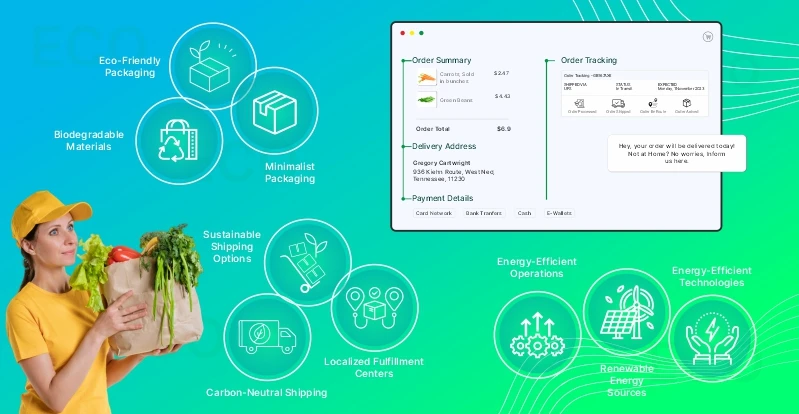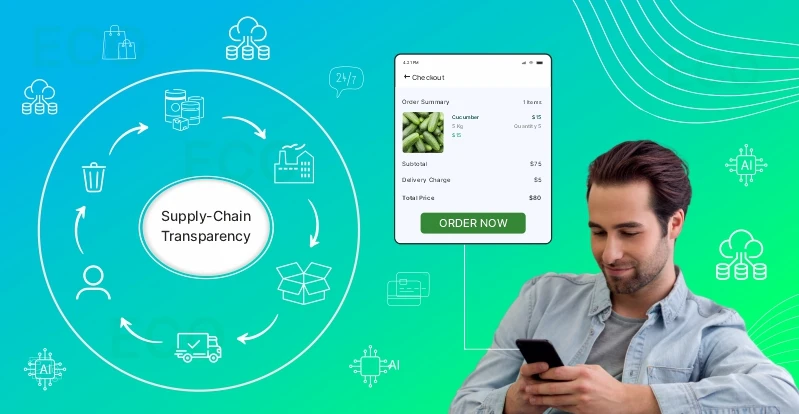Green eCommerce: Sustainable Practices for Online Retailers

E-commerce has grown a lot recently and has done well in facing challenges. Customers have always been cooperative and accepting of this industry. Earlier, going to brick-and-mortar retail stores was always a go-to choice for consumers, but now the perspective has changed.
And with easily accessible internet, the notion of “Green eCommerce” is becoming increasingly popular. Green eCommerce means the sustainable and environmentally friendly techniques or strategies used in the online retail industry. It covers the whole supply chain, from sourcing raw materials to packaging and distribution, and goes beyond simple product offers.
Customers caring more about the environment has made sustainable products and ethical business practices more popular and in demand. Online merchants have also started showing interest and understanding that to survive in this industry, they must adhere to these principles to satisfy their growing number of environmentally conscious customers as well as ethical obligations.
More than ever, consumers are knowledgeable and socially conscious nowadays. According to a Nielsen report, 73% of global consumers would change their buying habits to reduce their environmental impact.
Sustainability-focused goods and services are in high demand as a result of increasing awareness of the environment. To remain competitive and accountable over the long term, online retailers adjust to this change in customer behaviour and choices.
Environmental Impacts of Traditional eCommerce
This is a world where convenience is the king, and the environmental impact of eCommerce is becoming increasingly apparent. The click-and-click nature of eCommerce comes with a price tag, which is just a small part of the virtual world. Let’s explore the multi-faceted ecological impact of traditional eCommerce.
Packaging and Shipping’s Carbon Footprint
The worldwide movement of products from producer to consumer is a base of eCommerce.
Nevertheless, this enormous transportation network greatly increases the industry’s carbon influence. Long-distance shipment of goods, which frequently requires the involvement of a number of middlemen, increases fuel usage and greenhouse gas emissions.
Moreover, many packing materials used in conventional eCommerce are not biodegradable, which adds to the trash piling. Given the sheer number of packages that are transported daily, the environmental cost of packing materials from cardboard boxes to plastic bubble wrap becomes increasingly apparent.
Green eCommerce proposes an overhaul in packing procedures to solve this problem. Adopting minimum packaging and eco-friendly materials minimizes waste and energy usage needed in production and transportation, thus mitigating the overall carbon impact.
Generation of Electronic Waste
One of the main causes of the growing issue of electronic waste is the eCommerce industry’s quick turnover of electronic gadgets. Lots of electronics are thrown away because new devices keep coming out, and they don’t last very long.
E-waste, or electronic garbage, seriously threatens human health and the environment. Toxic materials are released into the environment due to improper recycling and disposal of electronic gadgets. In addition, habitat degradation and resource depletion are caused by the extraction of raw materials used to produce electrical items.
A sustainable eCommerce solution to this problem highlights product lifetime, repairability, and recyclability. The environmental effect of electronic waste may be considerably decreased by putting circular economy ideas into practice prioritising the reuse and recycling of goods during the design process.
Pollution and Depletion of Resources
The conventional eCommerce business frequently uses resource-intensive manufacturing techniques that worsen the environment. Deforestation, habitat loss, and degraded soil are caused by extracting raw resources like metals for electronics or wood for packaging.
Furthermore, energy-intensive procedures that frequently depend on non-renewable energy sources are used throughout the production phase. This adds to the contamination of the air and water and worsens the depletion of limited supplies.
A duration of change in manufacturing techniques is necessary to solve these issues. The depletion of resources and pollution linked to conventional eCommerce may be reduced by implementing eco-friendly materials, using renewable energy sources in production, and following rigorous environmental laws.
Sustainable Practices for Green eCommerce

Green eCommerce business has come about as a response to the environmental issues that regular eCommerce brings about, integrating various creative and responsible methods with it. These strategies are designed to lessen the ecological effect of online retail and are integrated into the supply chain and operating procedures.
Eco-Friendly Industry Packaging
Biodegradable Materials
A key component of green eCommerce is the switch from traditional packing materials to biodegradable substitutes. Compostable plastics, plant-based polymers, and recycled paper are examples of biodegradable materials that decompose organically and cause the least amount of environmental damage.
Online merchants can collaborate with package providers who are dedicated to eco-friendly solutions to apply this strategy efficiently. The packaging complies with environmental objectives while preserving the integrity and security of the items being sent.
Minimalist Packaging
Working with the Principle “Less is More,” Eco-friendly online retailers promote minimalistic packaging. This method focuses on making packaging bigger and using more materials to reduce waste and enhance sustainability in online shopping. Retailers reduce their environmental impact by removing extra layers and materials and reducing shipping costs.
But it’s difficult for brands to have a minimalistic approach. So, online retailers can do packaging audits, optimize dimensions, and find new design solutions. One can also hire or collaborate with designers and manufacturers who are experts in sustainable commerce solutions and good implementation.
Eco-Friendly Shipping Solutions
Green eCommerce places extreme value on using carbon-neutral shipping methods in recognition of the adverse environmental impacts of shipping. By investing in carbon offset schemes, online retailers can decrease the carbon emissions produced during transportation. By financing projects like reforestation or renewable energy projects, these programs successfully offset the ecological impact of shipping.
Customers can make better environmental decisions by providing carbon-neutral shipping alternatives during checkout. Open and honest communication about these activities builds brand trust and improves consumer perception.
Localized Fulfillment Centers
Fulfilment centres are strategically located to reduce shipping distances and carbon emissions. Online merchants can lower their environmental impact by strategically putting fulfilment facilities closer to their main client bases and optimizing delivery routes.
To improve the set-up of localized shipping solutions, you can work with third-party logistics providers, prioritize sustainability, and strategically locate fulfilment hubs.
A recent report by Statista stated that in the top 100 cities globally by 2030, the predicted environmental effect of e-commerce logistics would be substantially greater.
By the end of this decade, there may be 7.2 million delivery cars on the road, and 25 million metric tonnes of CO2 are expected to be released into the atmosphere due to freight and package.
Energy-Saving Procedures

Renewable Energy Sources
Using renewable energy sources to power operations is an important aspect of green eCommerce.By shifting to green energy sources like solar, wind, or other renewable energy, you could decrease your dependency on fossil fuels and the harm that energy use does to the environment.
Online retailers have tons of options to reduce harmful effects on the environment. They also purchase renewable energy credits, which support clean energy production. One can choose to work with green energy suppliers, who provide electricity from renewable sources.
Alternatively, they might invest in initiatives that lower greenhouse gas emissions in order to balance their energy usage. Finally, Ecommerce retailers can install wind turbines or solar panels on their properties as sustainable energy systems. Environmentally conscious consumers are favourable to brands. Moreover, they’re speaking candidly about these initiatives on a large scale.
Energy-Efficient Technology
Reducing energy consumption is largely driven by supply chain and operational processes that combine energy-efficient equipment. Technology is essential to reducing carbon emissions in eCommerce, from energy-efficient lighting in warehouses to improved data centre operation.
There are several ways to adopt energy-efficient technology. One way is by using data analysis to predict demand. Another way is by using smart building solutions.
Purchasing environmentally friendly goods is another approach to dealing with energy-saving technologies.
Green Badges and Labels
Labels and certifications are mirrors of checklists, directing customers and companies toward eco-friendly decisions. Customers who care about the environment want proof of eco-friendly practices and transparency, which these sustainability indicators provide. Let us look at green certifications and labels’ meaning, varieties, and effects in an e-commerce environment.
E-Commerce Eco-Certification Overview
Multiple eco-labels and certifications are available, each focusing on a different facet of sustainability. Brands want to show their commitment to being eco-friendly and understand the complexities of these certifications. Some well-known certificates consist of the following:
Fair Trade
The Fair Trade accreditation guarantees that goods are made ethically, with workers receiving fair compensation and safe working conditions. Although it started in the agriculture industry, it now includes a wide range of consumer goods in line with environmental and social responsibility values.
Forest Stewardship Council (FSC)
Responsible forest management is the main goal of FSC certification. Companies with FSC certification promise to source their paper and wood products from responsibly managed forests, helping to reduce deforestation and promote the preservation of biodiversity.
Cradle to Cradle (C2C)
Products are certified Cradle to Cradle based on their sustainable production practices, recyclability, and material health. This broad method pushes firms to create goods with a lifespan that reduces environmental effects and increases recyclability.
Importance of Green Labels
Green certifications and labels build trust, giving customers a dependable and expedient means of identifying ecologically friendly items. Appropriately placing these marks on product packaging and websites indicates a dedication to transparency and accountability. Being transparent is necessary for online retailers to establish and maintain customer confidence.
Case Studies of Profitable eCommerce Companies with Green Certification
Analyzing case studies of online retailers who have used green certifications properly offers verifiable proof of the benefits to brand image, customer loyalty, and overall company performance.
Patagonia
Patagonia, an established brand known for its dedication to social and environmental responsibility, is certified by many organizations, including Fair Trade and Bluesign. Patagonia’s prominent display of these certificates conveys its commitment to ethical and sustainable eCommerce practices relating to a conscious consumer base.
Etsy’s Carbon Counteract Program
Etsy, an online marketplace for vintage and handcrafted goods, started a carbon offset program to mitigate the environmental impact of transportation. Etsy tracks and lowers shipping-related carbon emissions and funds initiatives that offset identical emissions.
The specific examples listed above indicate the actual benefits of getting green certifications. They strengthen the brand’s legitimacy and draw in eco-conscious clients, encouraging word-of-mouth and participation.
Challenges and Solutions
Overcoming Cost Barriers
While implementing sustainable principles might initially be expensive, startups can profit from several low-cost options and incentives. Collaborative efforts, green funding, and government subsidies may help remove financial obstacles.
Education and Involvement of Consumers
It’s necessary to inform customers about how their decisions affect the environment. Government subsidies, ecological finance, and cooperative initiatives can help largely in removing financial barriers.
Initiatives and Partnerships for Collaboration
Being on good terms with other companies, NGOs, and governmental organizations can push the influence of sustainable eCommerce projects. Collaboration allows the sharing of resources and information and a group effort to create a greener eCommerce system.
Upcoming Trends in Green E-commerce
Technological Progress in Sustainable Areas
Eco-friendly online shopping will continue to improve with sustainable technology like biodegradable materials, renewable energy, and eco-conscious production methods.
Regulations and Policy updates
Government rules and regulations will change to meet the demands of the time. This will likely impact eCommerce by encouraging companies to be more environmentally friendly and adopt stricter sustainability practices.
Forecasts Regarding the Development of Green E-commerce
With a move toward circular economies, more integration of sustainable eCommerce practices, and new technological developments, the future of green eCommerce is full of new opportunities. As the environment changes, more companies will probably adopt broad plans for sustainability.
Wrapping Up
Green eCommerce is an amazing approach focusing on sustainable practices throughout the online retail supply chain. Accepting and adopting eco-friendly practices, such as energy-efficient operations and packaging, is helping the environment overall, and it also helps companies match the standards of a growing number of eco-conscious consumers who are adjusting to new norms.
So, with all of the efforts, companies help the environment and promote themselves as market players in a market where consumers increasingly choose products with less environmental impact. Consult with industry experts to integrate green eCommerce into retail and ensure business success.




